Definition of analog: of, relating to, or being a mechanism or device in which information is represented by continuously variable physical quantities
Merriam Webster Dictionary
Introduction
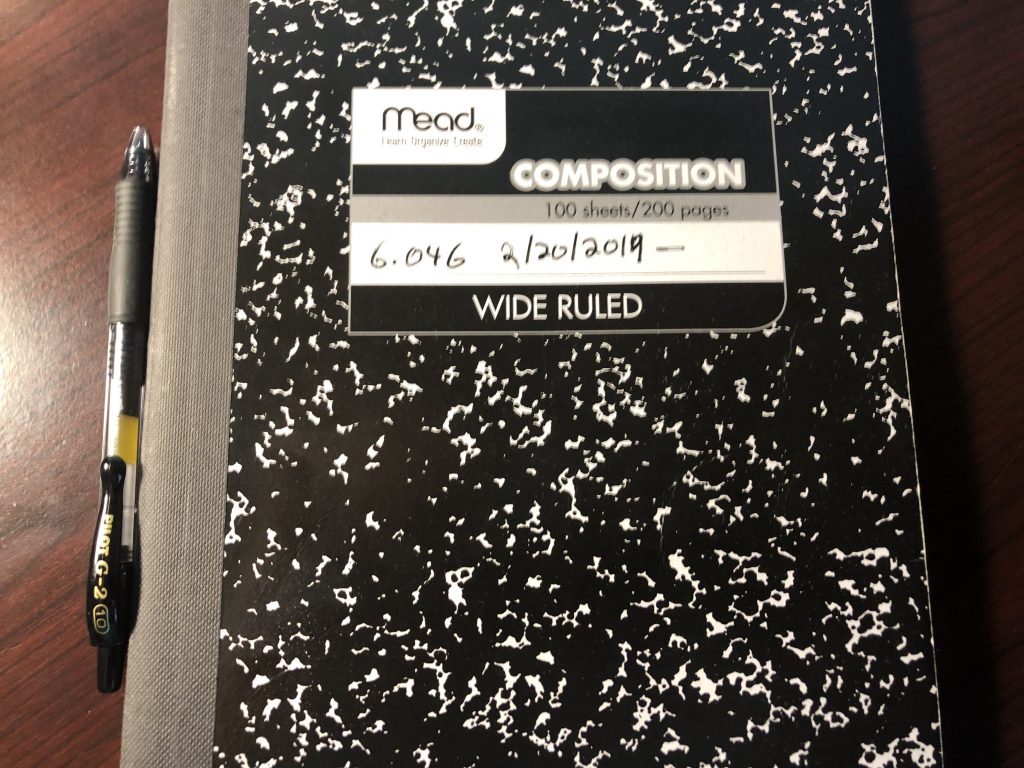
I just finished going off on a major tangent away from my normal home computer pursuits such as studying algorithms, messing with Nethack source code, or practicing Python programming. Prior to this diversion I pursued these computer-related activities for learning and fun in my free time outside of work. But I spent the last three months pursuing activities related to pens, pencils, paper, and notebooks. Some people like to call using a pen and notebook an “analog” activity, so I used that word for the post title.
For several years my primary analog tools have been cheap wide ruled composition notebooks and Pilot G-2 gel pens. For example, I used a composition notebook to keep track of the homework and tests for my OpenCourseWare algorithms classes. I also used a composition notebook for non-technical purposes such as taking notes about things I read or heard, or just writing about things going on in my life. But otherwise most of what I wrote down was in computer form. I use Microsoft Outlook for my calendar at work and keep notes and tasks in Microsoft Word documents and text files, both in the office and on my home laptop. A lot of information was just kept in email. I have stuff on my iPhone.
But back in May I started looking at better ways to use pens, pencils and paper. I started looking on the internet for reviews and recommendations of what to buy and I ended up spending a lot of time and probably a few hundred dollars trying out different products and coming up with my own preferences. Finally, a couple or three weeks back I finally stepped back from going deeper and deeper into this exploration of pens, pencils, paper, and notebooks. I had spent enough money and time researching the best options. Now it was time for me to just use the tools I had and not buy any more and not read any more about them.
Now that I have stopped exploring these analog tools, I thought I should write a blog post about what I learned. I have a bunch of bookmarks of interesting web sites that I found helpful. I also have the results of my own use of the tools. Clearly, I am not a pen, pencil, paper, or notebook expert. This is an Oracle database blog and my strongest skills are in the database arena. Also, would people who read this blog for Oracle tuning scripts and information care about pens and paper? I am not sure. But the information that I learned and gathered has been helpful to me and it has been fun. Maybe others can benefit from my experience and if they want more expert advice, they can follow the links in this post to people who specialize in these areas.
I have decided to break this post, which is almost surely going to be my longest to date, into sections that alternate between things you write with and things you write on. Here is the outline:
- Introduction
- Pilot G-2 Gel Pens
- Graph Paper
- Pen Party
- Bullet Journal
- Fountain Pens
- Rhodia Dot Pads
- Pencils
- Conclusion
Lastly, I want to end the introduction with a caveat that is like those I find in a lot of the pen and paper blogs. I will have links to various businesses that sell products like pens or notebooks. I have not received any money to advertise these products, nor have I received any products for free. I bought all the products with my own money. As I mentioned in my privacy page, this blog is completely non-commercial and does not generate income in any way. I do not sell advertising or people’s emails to spammers or anything like that. My only income is from my job doing Oracle database work. I like having a blog and I cough up a couple hundred dollars a year for hosting, a domain name, and a certificate so I can put these posts out on the internet. So, don’t worry that I’m trying to sell you something because I am not.
Pilot G-2 Gel Pens
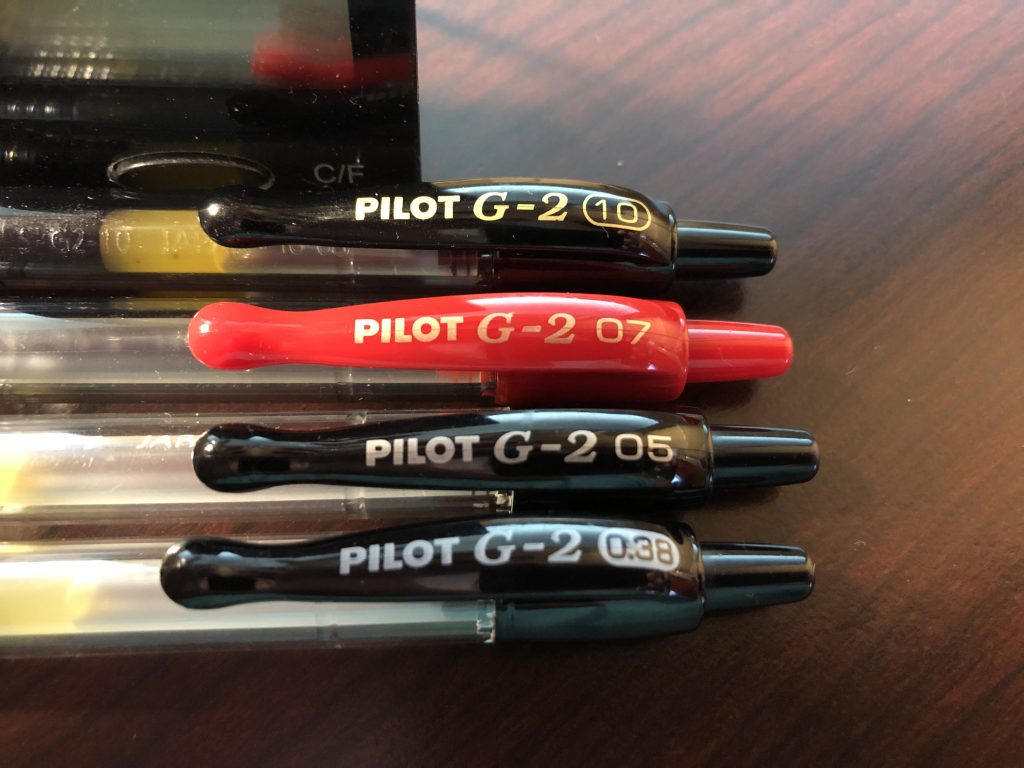
I have been using Pilot G-2 gel pens for several years but did not realize that they came in different widths before I started researching all of these analog tools. I was using my gel pen with my composition notebook and kept accidentally smearing the ink. So, I finally Google searched for something like Pilot G-2 review and that really kicked off all of this research into types of pens and related tools. I found out that Pilot G-2 pens came in four width tips and that I had accidentally bought the widest tip pens which are the worst at smearing. They just put the most ink on the paper. I looked back at my Amazon orders and found that I bought a dozen “Fine Point” G-2 pens in 2015, but when I ran out and reordered 12 more in 2017, I got the “Bold Point” which has a thicker line. If you look at the pictures on Amazon, the boxes look very similar. You must know what the widths are named. So, as simple as this sounds, it was helpful to learn about the different tip sizes of my favorite gel pens and to try out each size to find which one I wanted. Here is a table of the four sizes:
| Clip # | Millimeters | Name | # Colors |
| 0.38 | .38 | Ultra Fine | 4 |
| 05 | .5 | Extra Fine | 5 |
| 07 | .7 | Fine | 16 |
| 10 | 1.0 | Bold | 8 |
The clips of the pens have numbers on them but only the .38 millimeter tip has a decimal point so that can be confusing. The .38 mm pen writes a very thin line. Evidently several manufacturers compete for the very thin line gel pen market. I have tried all four G-2 sizes and right now my favorite is the .5 mm extra fine.
I got the number of colors from Pilot’s site. It looks like the .7 mm fine has the most colors. I pretty much just use black, but I like red for editing.
A key thing that I learned about testing a new pen is that you must write a lot with it before you really know if you like it. Gel pens seem to start out a little uneven when you first write with them. Maybe they have been on a shelf somewhere for a long time. But after you write say 5 pages the ink starts to really flow well.
As I said in the introduction, I liked the Pilot G-2 gel pen before all this investigation began. But I know so much more about my favorite pen such as the different sizes. I will talk about this later, but one result of all this research is that I have started to like pens that write thinner lines. I accidentally bought a dozen of the thickest line G-2 pens in 2017 and it almost threw me off the pen. Now I have settled down with a G-2 pen with a tip half the size of the one I struggled with and it has really helped me out.
Graph Paper
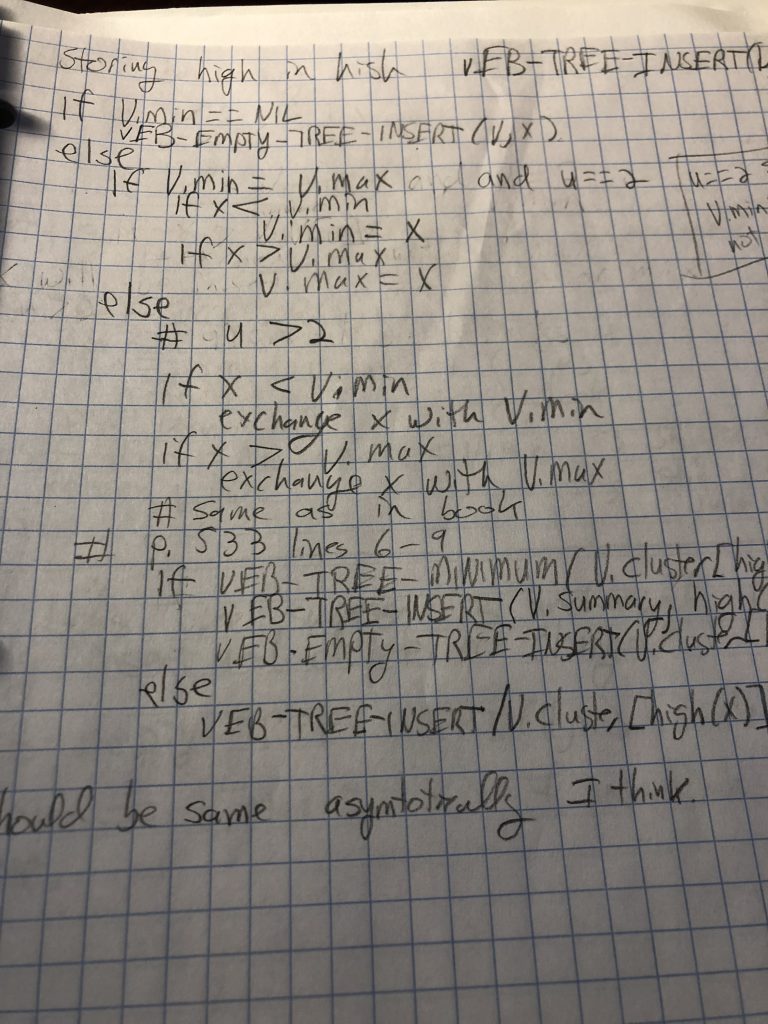
I got the idea of switching to graph paper from the handwritten lecture notes from an algorithms class I was working through. Evidently the professor wrote out his notes using several color pens on graph paper. It made me wonder if I should use graph paper too.
I had already started using lined loose leaf filler paper in addition to composition notebooks. I think part of the problem is that it has been 30 years since I was a student in school, and I am out of practice using paper and 3 ring binders and all. My daughters use all these tools in school without thinking about it but for me the idea of using some loose filler paper is a revelation. Maybe some of this is not so much learning but relearning how to use these analog tools that I used regularly during my school days.
The lined filler paper was great as scratch paper when I was working on a problem for my online class but then I could clean up the answer and write it in my sturdy composition notebook to keep long term. But it made sense to get graph paper instead of lined paper because it would help to line things up along the vertical lines. If I need to write some code or pseudo-code and line up blocks within loops or if statements, I can use the vertical lines. The horizontal lines just separate the lines of code.
I ended up buying a nice pad of graph paper from Amazon but didn’t realize that some of the lines were darker than others. I prefer the lines to all be the same darkness. Then I ended up returning something that I bought from Office Depot with a gift card and they would not give me cash back. So, I used the gift card that was the refund to buy several pads of loose three-hole punched graph paper as well as two or three composition books with graph paper instead of lines. The composition books are kind of neat but they seem a little cheap and flimsy.
Of the three types of graph paper that I tried I like the Office Depot loose paper the best. All the lines are the same darkness and it is already three-hole punched so I can throw it in a binder if I want to keep it. I can use it for scratch paper, or I can save what I write down. So, at this point I like my loose paper to be graph paper but I still like the wide rule lined composition notebooks over the ones with graph paper.
Pen Party
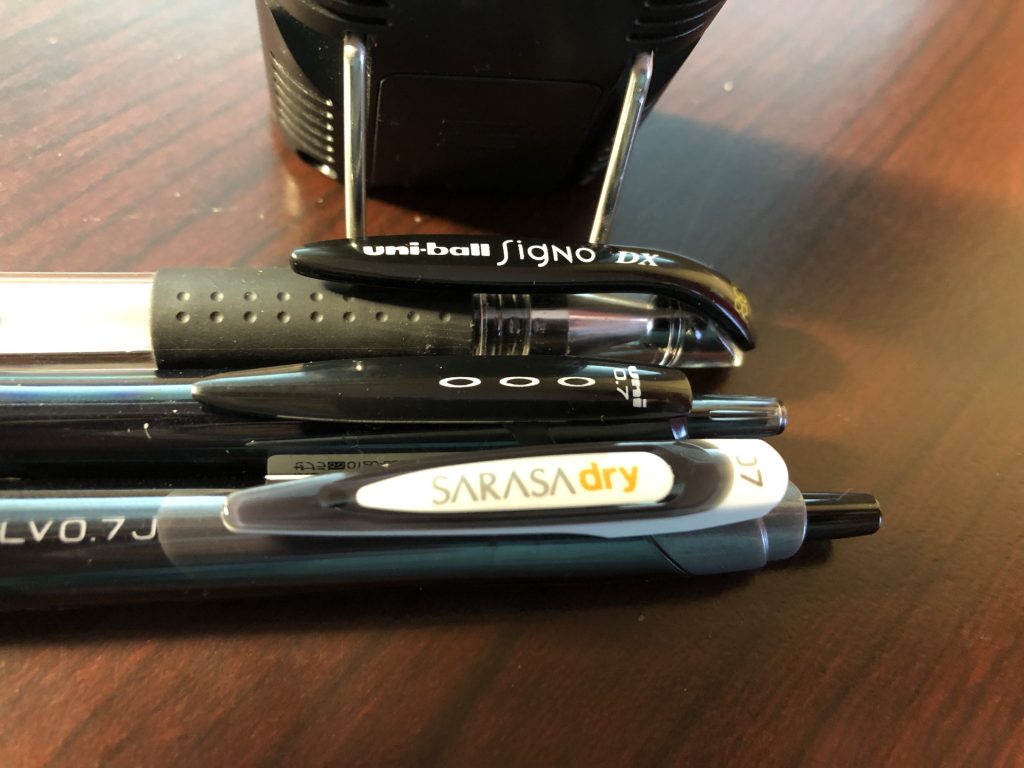
After reading the Pilot G-2 review I started reading reviews about other pens. Several web sites have best pen lists. The Gentleman Stationer has a nice best pens for 2020 page. The Pen Addict has lists of top 5 pens in different categories. Lastly, the online store JetPens, which specializes in Japanese pens, has their list of 33 best pens for 2019. One challenge that I had when I was looking at the different widths of G-2 pens is that I ended up buying packs of 4 or more pens on Amazon when I really just wanted one black pen to test. JetPens.com sells individual pens. If you spend $25 or more, you get free shipping. So, to test out some of the pens I had been reading about in the top pen lists I ordered several different kinds of pens, pencils, and an eraser, one of each kind.
Here was what I bought in my first order:
Uni-ball Signo UM-151 Gel Pen - 0.38 mm - Black $2.85 Pentel EnerGel Euro Needle-PoinT - 0.35 mm - Black $2.50 Platinum Preppy Fountain Pen - Black - 05 Medium Nib $4.00 Tombow Mono 100 Pencil - HB $2.35 Zebra Sarasa Dry Gel Pen - 0.7 mm - Black $2.95 Sakura Foam Eraser W 80 $1.50 Sakura Pigma Micron Pen - Size 02 - 0.3 mm - Black $2.50 Tombow Mono Drawing Pen - 03 - Black $2.89 Tombow Fudenosuke Brush Pen - Hard - Black $2.75 Uni Jetstream Sport Ballpoint Pen - 0.7 mm - Black Ink $3.15
Some of these were suggested by Bullet Journal enthusiasts but I will talk about that in a later section. I will also talk about fountain pens and pencils later. The point here is that JetPens.com is cool. You must chunk up your purchase to be $25 or more but it is nice picking out individual pens to try them. One of the reasons I wanted to write this post is that I wanted to share about fun vendors like JetPens for people like me who had never heard of them before.
I took these things from my JetPens order and other pens and pencils that I already had and convinced my wife and three daughters to join me for a “pen party” to try them out. We sat around out kitchen table passing around groups of similar pens and pencils and tried each one out. After everyone finished trying them, we all picked our favorites.
My favorite was the .38 mm UM-151 or Signo DX gel pen. I have been using the Signo DX pen for tiny writing in a smaller notebook where it helps to have the smallest possible lines. I think it is slightly better than its G-2 .38 mm competitor. But I prefer the .5 mm G-2 gel pen for writing on full size 8 1/2 x 11 inch paper. So, my favorite gel pens are the .5 mm G-2 for normal writing and the .38 mm UM-151 for extra small writing.
My wife and two of my daughters preferred the Zebra Sarasa Dry .7 mm gel pen because it had the thick line of the .7 mm G-2 pen but with fast drying ink so that it did not smear. I’m not as big of a fan of the Sarasa Dry because the clip kind of sticks out and gets in my way. I may also just be a Pilot G-2 loyalist. Also, I have moved toward the thinner lines so the fast dry ink is not as important to me. We have a few of these Sarasa Dry pens in our pen cup in our kitchen.
My youngest daughter liked the Uni Jetstream Sport .7 mm ballpoint pen. This pen draws a finer line than you would think a .7 mm pen would because it is a ballpoint and not a gel pen. It also does not smear and is waterproof. We got her a bunch of these to take off to college as an incoming freshman this year.
We did not have this pen for our pen party but I wanted to mention the space pen that my family got me for Father’s Day. I carry it around in my pocket with my iPhone 8. I do not like the way the ink looks nearly as well as that of my gel pens, but the space pen is supposed to write at any angle and even on wet paper and it is mostly waterproof. Plus, it comes in a just under 4-inch-long bullet shape that fits comfortably in my pocket and cannot leak. The space pen gives me a way to write on just about anything when I am away from my home or office.
I am not a pen expert, but I thought I would pass along my own experiences as well as the links to the much more knowledgeable bloggers and vendors with their top pens lists. Someone out there might enjoy the top pens lists and trying out individual pens as much as we did. It was fun and even practical.
Bullet Journal
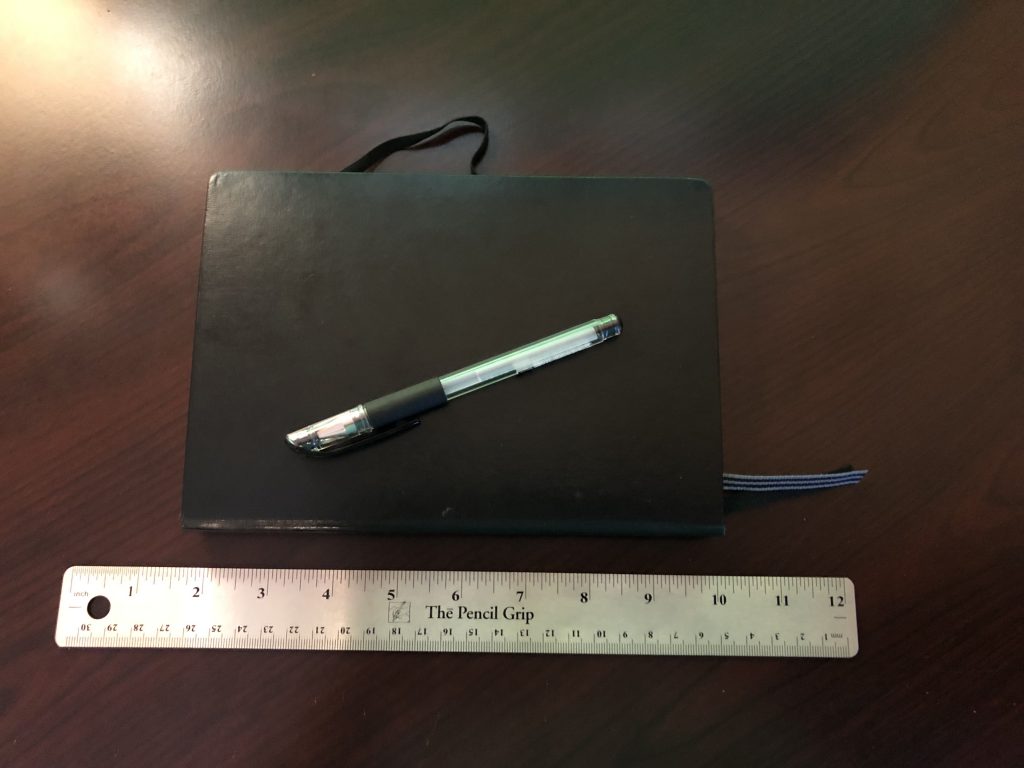
At some point in this analog detour I started a Bullet Journal or BuJo for short. The main web site describes a BuJo as “The Analog Method for the Digital Age”. It sounds a little pretentious to call it “the” analog method instead of “an” analog method as if the Bullet Journal cures all ills. But I took the term analog from there to name this post. This post focuses on the analog tools and not the underlying philosophy or psychology behind the Bullet Journal. If you want to go deeper into that I recommend starting on the web site and then reading the book. I do not endorse everything in the book and web site or know if this method of journal writing really has all the claimed benefits. But I do endorse the tools that I have used such as the notebook which is very cool.
The Little Coffee Fox blog has a nice list of Bullet Journal supplies. I bought the black Leuchtturm1917 A5 Dotted Hardcover Notebook for my journal in May. A lot of the BuJo enthusiasts recommend this notebook. Even if you never get into bullet journals you might want to try one of these notebooks. The pages have dots instead of lines which is kind of like graph paper but less intrusive. The paper is nice quality and the notebook is hardbound and sturdy. The pages are numbered. I am writing this on August 25th, so I have been using my notebook for over 3 months. I like it a lot. Even if all the BuJo philosophy/psychology/method does not appeal to you the notebook itself is worth checking out.
I have tried several of the other BuJo supplies but I mainly use my Signo DX UM-151 .38 mm gel pen with my Leuchtturm A5 notebook along with a ruler. I got a foot long metal ruler with cork backing. I probably could have used any old straight edge just as well. I use it to draw lines and make boxes. I have not gotten into drawing and lettering as some BuJo enthusiasts do but I have purchased a couple of pens and a stencil to try. But I cannot really endorse something I do not use.
The Bullet Journal is all about using paper and pens instead of a computer which is really what this blog post is all about. What tools have I checked out to use offline? Can they work together with my computer tools to make me more productive and to help me have more fun?
Fountain Pens
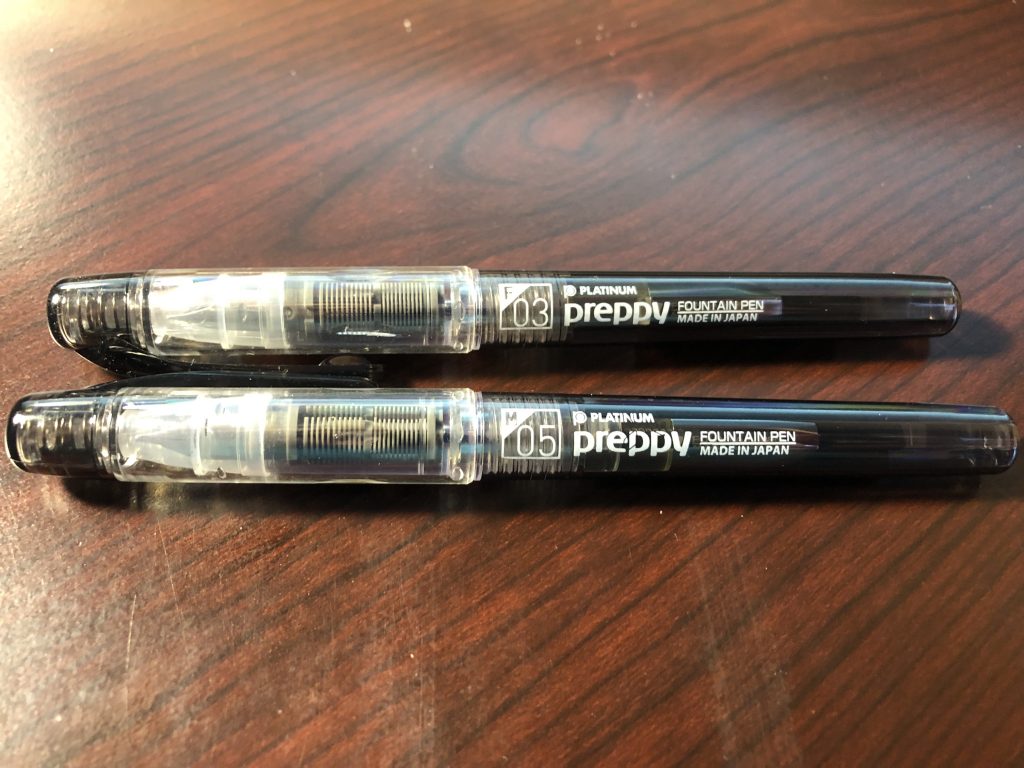
I added a $4 fountain pen to my first JetPens order on a whim. I had to get the order up to $25 to get free shipping and $4 was reasonable for a fountain pen. If you look at the top pen lists above you will see that beginner fountain pens tend to run around $15 and yet my $4 Platinum Preppy was still considered a good pen. I got a second Preppy with my second JetPens order. The first was a medium nib and the second a fine nib. The medium has a .5 mm tip and the fine .3 mm. I had a lot of fun playing with these two pens. I ended up getting two matching converters so that I could use them with bottled ink and then I bought a nice bottle of black ink. Before I bought the full bottle of ink I got an ink sample and a pair of ink syringes so I could test out the ink.
While I experimented with my two Preppies I got a lot of helpful advice from the Reddit fountain pens group. Also vendors like JetPens and Goulet Pens have helpful videos and pages such as how to fill a fountain pen, how to clean a fountain pen, and how to use an ink sample. I think it makes good sense to start with a less expensive fountain pen and learn the ropes. The stereotypical experience of a new fountain pen user is that they do not learn how to take care of the pen, it stops working, and ends up in the back of a drawer unused. For example, I had trouble with the ink flow in my Preppies, so it helped to get advice on cleaning them and getting the ink flowing better.
After playing with my Preppies for a while I decided to get a nicer pen. If you read the top pen lists the break fountain pens into price ranges like “under $50”, “$50 to $100”, and “over $100”. I tried to be good and get a pen in the middle range, but I had my eye on several gold nib pens in the over $100 range. Japanese fountain pens mess up these neat price ranges because some pens that cost over $150 in the US can be purchased for less than $100 if you buy them directly from Japan. So, I told myself that I could get a $170 Platinum 3776 gold nib pen from Japan for under $100 and that is still in the middle range. This led to a lot of stress and frustration. I tried eBay first. A week after eBay charged over $80 to my credit card, I got an email from the seller saying that my pen was not in stock and did I want a blue one instead of the black one I ordered. I cancelled the order, but it took several days to get my money back. Then I ordered the same pen from a seller on Amazon and that was a total scam. Criminals broke into some poor unsuspecting inactive Amazon seller’s account and redirected the account to their bank account. Then they put out a bunch of bogus products at bargain prices including the fountain pen that I ordered. It took me a little over two weeks to get my money back.
After three or four weeks of frustration trying to buy an expensive fountain pen at a discount directly from Japan, I decided that it made more sense to buy from a reputable dealer in the US. I bought my 3776 at Pen Chalet and the buyer experience could not have been more different from my eBay and Amazon experiences. I got the black pen with gold trim and a fine nib. Lots of people on the fountain pens group on Reddit swear by buying fountain pens from Japan and they have more experience than I do. I suggest that wherever you buy your expensive fountain pen that you contact the seller first and ask them if they have the pen in stock. If they do not respond to your message, then run away very fast. Also, you probably should not try to get the best deal. Pay $20 more to buy the pen from a well-known dealer in Japan that sells a lot of fountain pens instead of going for the lowest price. Or just forget shopping for bargains from Japan and go with a well-regarded US vendor like Pen Chalet. I did contact Pen Chalet about something else before buying my pen and they responded quickly. A quick response to a question is a good sign for fountain pen sellers.
My Platinum 3776 pen writes like a dream. I have the matching gold colored converter and I use Aurora Black ink. It writes a nice thin black line, kind of like the ones my .5 mm G-2 and .38 mm Signo DX gel pens write. The big question is why spend $179 (including sales tax) for a fountain pen when a $3 gel pen makes pretty much the same line? I am not sure. Some people argue that fountain pens are better for the environment because you can fill them with bottled ink but with other pens you use them once and throw them away filling up landfills with plastic. Someone on the internet said, “gel pens are for work and school and fountain pens are spiritual”. I am not sure what they meant by spiritual but using a high-quality fountain pen is a nice experience. I keep mine at home, so I do not lose it somewhere like all my other pens. It is kind of nice to sit down at my kitchen table and write with my fountain pen. Maybe someone will read this post and find enjoyment in fountain pens themselves.
Rhodia Dot Pads
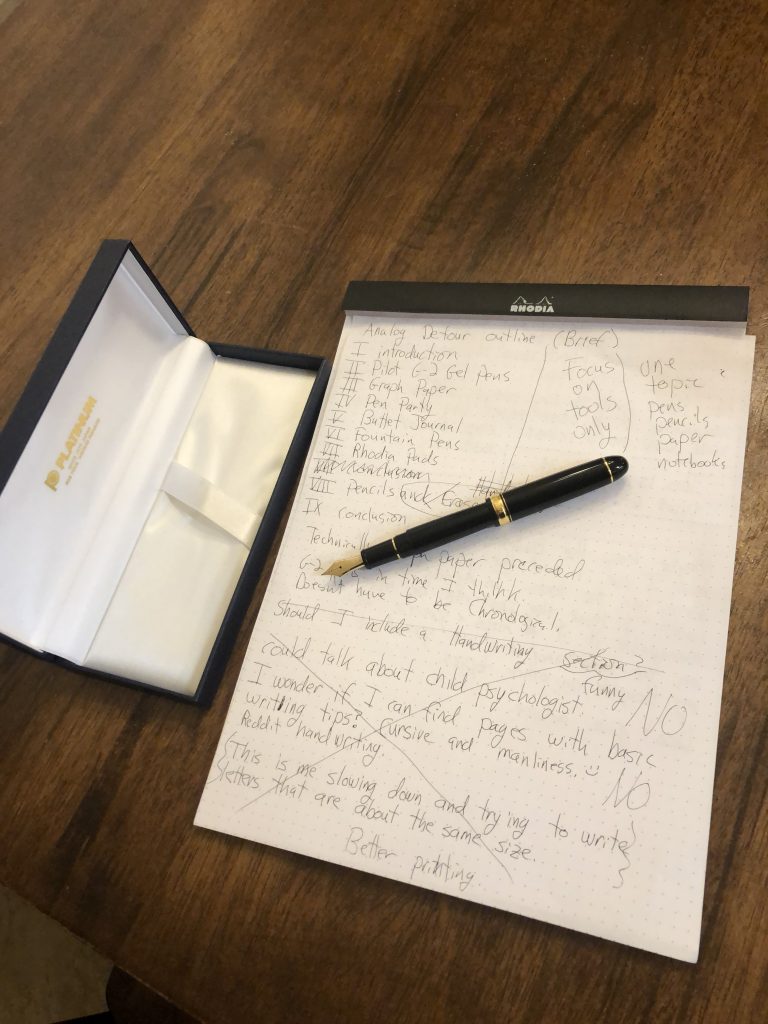
Once I got into fountain pens, I needed some nice paper to write on. Many paper brands advertise as fountain pen friendly but I focused on Rhodia Dot Pads. These have dots like my Leuchtturm bullet journal notebook, but the pages are perforated so they can be removed. I started with the 6 x 8 1/4 inch pad because it was the best deal. I ended up writing on both sides of all 80 sheets and trying out different kinds of pens and pencils on it. We used these sheets in our family pen party. When I finished off this pad I bought the more expensive 8 1/4 by 11 3/4 inch pad and I really like it. I three-hole punch the pages after I rip them off and save them as fountain pen writing samples. I get a lot of enjoyment writing with my gold nib Platinum 3776 fountain pen on my full size Rhodia dot pad.
Before I started this analog detour, I wrote in a composition book with a gel pen. Today I write on my Rhodia pad with a fountain pen. One thing about the Rhodia paper is that it is smoother and less absorbent than cheaper paper. As a result, pens draw thinner lines on Rhodia paper. This probably would be more important with really wide fountain pen nibs, but it is nice that my fine nib pen leaves a nice sharp thin black line. The Rhodia paper is more expensive. At this instant you can get a full size Rhodia pad for $14.99. It has 80 sheets so that is about 19 cents per sheet. A 5 pack of Mead composition books will run you $16.75 for 500 sheets which is less than 4 cents per sheet. Is the Rhodia pad worth over 4 times as much? Why not stick with my Pilot G-2 .5 mm gel pen and write on Mead wide ruled composition books instead of using my Platinum 3776 fountain pen on a Rhodia Dot Pad? I think I could be happy with either. There is a small advantage to the more expensive pair. The fountain pen does not show through very much on the Rhodia paper. The gel pen shows through on the Mead composition book in my testing. At the end of the day, I just enjoy the Rhodia pad like I enjoy the nice fountain pen. It goes beyond simple practicality even though there are some practical benefits of the more expensive Rhodia pads.
Pencils
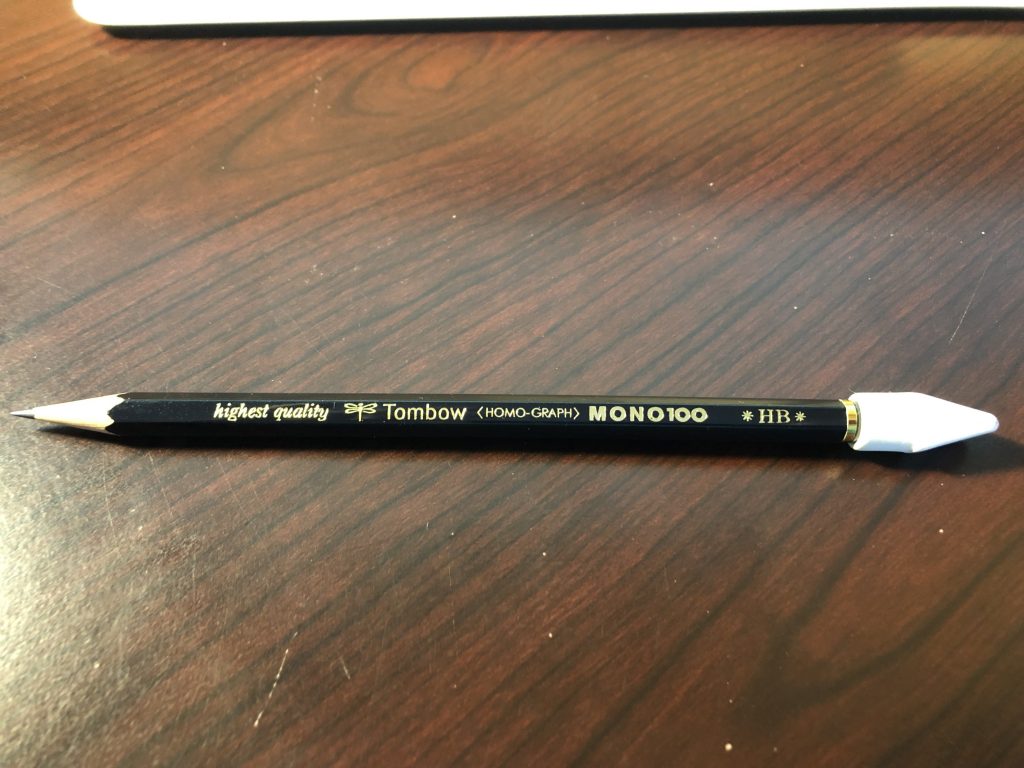
The last type of analog tool that I checked out was pencils. I have not been using pencils at all in my work or in my computer science study at home. But I remember back in college writing my Pascal code in my first CS class all on paper. The TA that graded my programs said that I had the third least amount of CPU usage of anyone in the class and that the other two with less CPU usage than me dropped the class. I had been programming in BASIC and FORTRAN before coming to college so learning Pascal was not that hard. But I liked to write code out with pencil and edit using an eraser, so I did not spend a lot of time on the computer screen. These days I mainly do things on the screen. I think I need to get back to using pencils and erasers for writing and editing code and pseudo-code both in my online class and for work. I guess that goes along with the analog way of thinking like the bullet journal philosophy of using a notebook and pen instead of a program or app for your planner and journal.
My favorite pencil that I tried was the Tombow Mono 100 HB pencil that I bought in my first JetPens order. It is a pretty thing. It is basically a drawing pencil. It writes a nice dark line and is very smooth. When I was trying out various pencils, I found a fantastic pencil store called CW Pencil Enterprise. You can buy individual pencils of all kinds including types from countries all over the world. I only bought two or three pencils, but they were great to order from. They included a nice handwritten note written with a pencil. Vendors like CW Pencil motivated me to write this blog. JetPens, Goulet Pens, Pen Chalet, and CW Pencil were all very nice stores to buy from. I am sure that they are not perfect, but I had a great experience with them all and I wanted to share that with other people.
In addition to pencils I also looked at erasers. The Sakura Foam Eraser that I got from JetPens is a step up from the traditional pink hand held eraser. It erases all the pencil marks and leaves less stuff behind. A couple of my pencils like the Tombow Mono 100 did not have erasers on the end so I got a pack of Pentel Hi-Polymer Eraser Caps. These convert a drawing pencil into a more conventional writing pencil with eraser. When I use pencils for programming I alternate between the erasers on the end of the pencil and the stand-alone foam eraser.
As much fun as I had looking at pencils, I really did not find much difference between them when I used them for hand coding. The much less expensive Dixon Ticonderoga pencils that my children and wife swear by worked really well for me. I can barely tell the difference between them and the Tombow Mono 100. The Tombow is a little darker and smoother but it really does not matter much for what I need. So, I splurged on the expensive fountain pen but at this point I’m pretty much sold on the affordable and quite nice Dixon Ticonderoga standard in pencils.
Conclusion
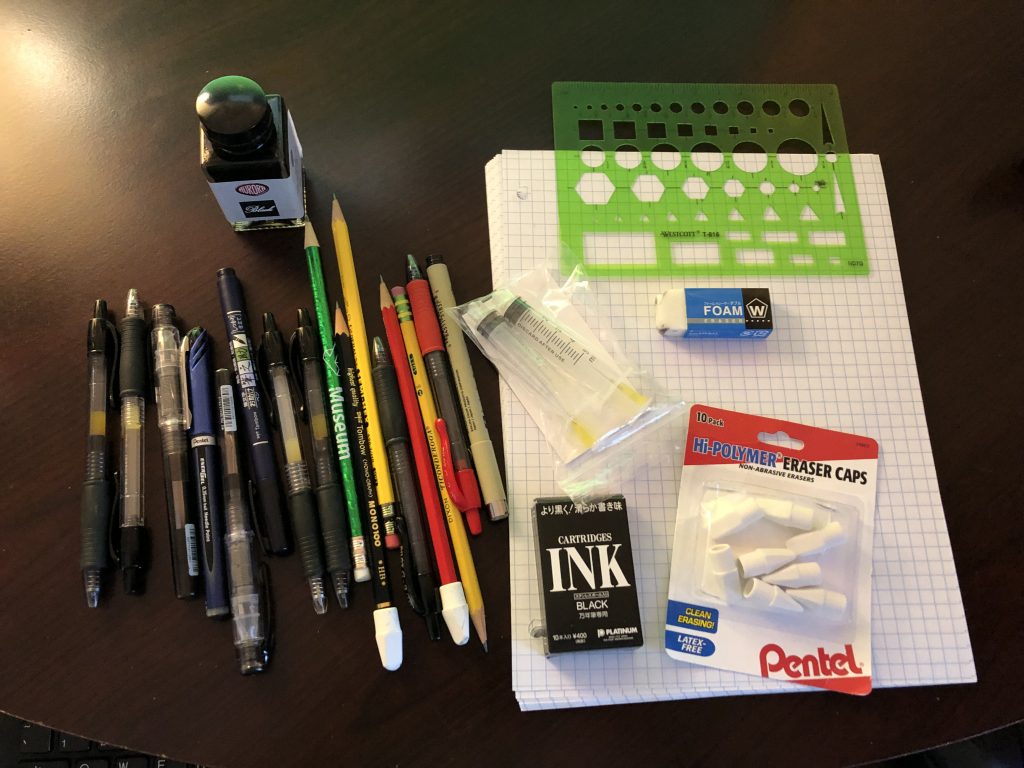
I went back on forth on whether I should write this post and what to put in it. There is a lot more that I could talk about that goes beyond just the tools themselves and I thought about writing multiple posts. But, really, this is a DBA blog and not a pen, pencil, paper, and notebook blog so one post is probably enough. I thought about making this a lot shorter and just having links to the various web sites and products without explanation – bullet points with URLs behind them. I settled on a pretty long single post that weaved my personal experiences from the past 3 months or so in with links to the sites and products.
My exploration of these “analog” tools is like a breadth first search of a very large search tree of products and information. For example, there are many kinds of fountain pens and each pen has multiple nib sizes. How many pens would you have to buy to really try them all? If you look at Platinum’s 3776 site there are many different colors and designs of this one pen, plus multiple nib sizes for each. Then there are the other manufacturers each with multiple pens. It is a huge search tree. I got just a little way into this massive search and pulled the plug. This post documents the results of how far I got. I thought about waiting a year before writing a post about this to see if I am still using these tools and what benefits I got from them. But, by then I would have forgotten much of what I learned in my initial search. Maybe a year from now I can follow up with a post about whether this detour has had a lasting positive impact on my work and personal life.
Thanks to everyone who checks out this post. If you have questions or comments, it would be great if you left them below. I hope that something in here will be helpful to others. I had a lot of fun and learned a few useful things.
Bobby


I appreciate this, Bobby! Just a few months ago I was re-evaluating my choice of favorite pen. I’m conflicted because I like the Pilot G-2, but I’ve had accidents carrying pens without caps in my pockets. So I switched to the Pilot Precise V5 rollerball years ago. Then I realized that I could find pens with caps that take the G-2 refills. Now you’ve inspired me to look into notebooks and good paper…
Thanks! I hope I have not led you too far astray. The pen and paper stuff can become addictive. 🙂
Jetpens.com has an interesting feature where you choose a pen refill such as for the G-2 pen and it shows you compatible products including pen cases.
https://www.jetpens.com/Pilot-G2-Gel-Pen-Refill-0.7-mm-Turquoise-Pack-of-2/pd/13107/compatible
The Signo DX UM-151 pen has a cap if you want a gel pen with a thin line. But there are a bajillion other options to check out.